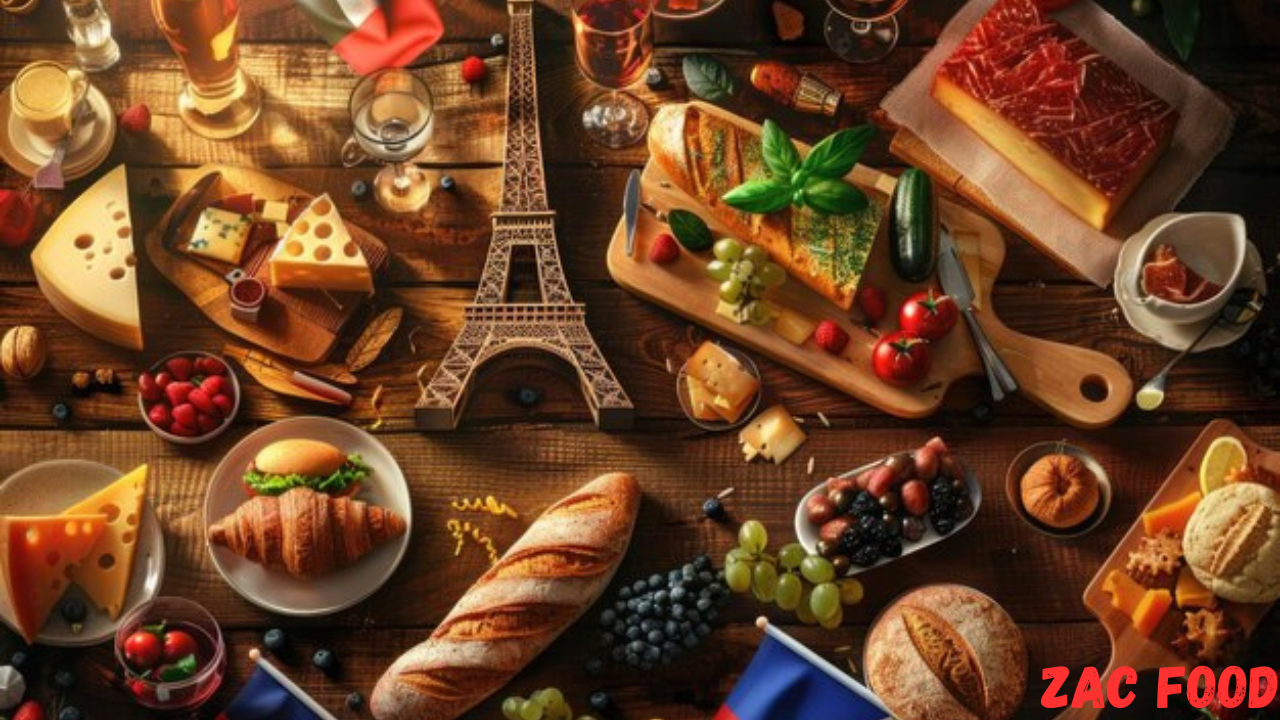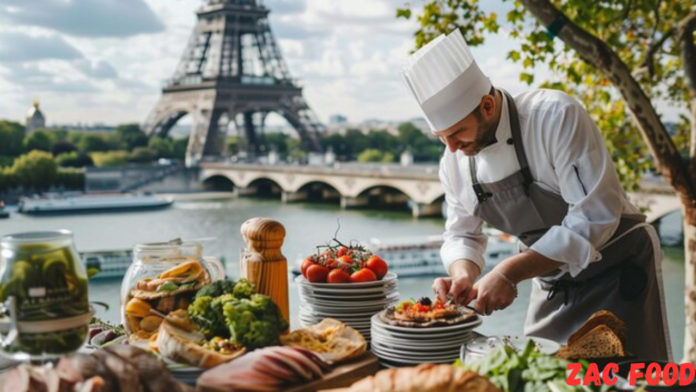When you think of France, chances are, food comes to mind almost immediately. French cuisine is not just a collection of dishes; it’s a deeply ingrained part of the nation’s identity. The food culture in France is revered worldwide, influencing chefs and food enthusiasts across the globe. From the bustling markets filled with fresh produce to the meticulous techniques taught in culinary schools, France food culture is a rich tapestry that tells the story of its history, regions, and people.
The Importance of Food in French Society
Food in France is more than sustenance; it’s a cornerstone of social and cultural life. In France, meals are occasions to gather, converse, and enjoy each other’s company. Whether it’s a casual weekday lunch or a festive holiday feast, food is central to the French way of life.

A Historical Overview of French Cuisine
French cuisine has evolved over centuries, shaped by historical events, regional influences, and a tradition of culinary excellence. The Renaissance brought new ingredients from the New World, and the French Revolution democratized cuisine, making it accessible to the masses. Today, French food culture is a blend of tradition and innovation, where old-world recipes coexist with modern culinary techniques.
Food as a Social and Cultural Bond
In France, food serves as a bond that brings people together. Family meals, social gatherings, and even business meetings often revolve around shared meals. The French take pride in their culinary heritage, and meals are seen as an opportunity to celebrate this culture, passing down recipes and traditions from one generation to the next.
Regional Diversity in French Cuisine
One of the most fascinating aspects of France food culture is its regional diversity. Each region of France boasts its own unique culinary traditions, shaped by local ingredients, climate, and history.
The North: Rich and Hearty Dishes
The northern regions of France, such as Normandy and Brittany, are known for their rich, hearty dishes. Here, you’ll find an abundance of dairy products like butter and cream, which are used in dishes like quiche and creamy soups. The seafood from the Atlantic coast also plays a significant role, with dishes like moules marinières (mussels in white wine) and fresh oysters being local favorites.
The South: Mediterranean Influences
In contrast, the cuisine of Southern France, particularly in Provence and the French Riviera, is lighter and heavily influenced by Mediterranean flavors. Olive oil, garlic, and fresh herbs like thyme and rosemary are staples. Dishes such as ratatouille, bouillabaisse, and salade niçoise showcase the vibrant, sun-soaked produce of the region.
Central France: Traditional and Rustic Flavors
Central France, including regions like Burgundy and Auvergne, is known for its traditional, rustic cuisine. This area is famous for its meats, cheeses, and wines. Dishes like coq au vin (chicken braised in wine) and boeuf bourguignon (beef stew in red wine) are classics that have been enjoyed for generations.
The Art of French Cooking
French cuisine is renowned for its attention to detail and technique. The art of French cooking is about mastering the fundamentals, from making the perfect sauce to using the freshest ingredients.
Classic French Cooking Techniques
French cooking techniques are the foundation of the country’s culinary excellence. These methods, taught in culinary schools and passed down through generations, are essential for creating the flavors and textures that define French cuisine.
Sauces: The Foundation of French Cuisine
Sauces are a cornerstone of French cooking. The five “mother sauces”—béchamel, velouté, espagnole, hollandaise, and tomato—are used as bases for countless dishes. Mastering these sauces is key to understanding and appreciating France food culture.
The Significance of Fresh Ingredients
Fresh, high-quality ingredients are crucial in French cooking. The French emphasize seasonal and local produce, and markets are a vital part of daily life. Whether it’s vegetables, meats, or cheeses, the freshness of ingredients is paramount to the success of any dish.
Mastering the Basics: Sautéing, Braising, and Baking
Sautéing, braising, and baking are basic cooking techniques that are integral to French cuisine. Each technique serves a specific purpose, whether it’s to develop flavors through sautéing, tenderize meats through braising, or create the perfect crust on a baguette through baking.
The Role of Chefs and Culinary Schools in France
France has produced some of the world’s most famous chefs, and its culinary schools are considered among the best in the world. These institutions play a significant role in preserving and advancing French food culture.
Famous French Chefs and Their Influence
French chefs like Auguste Escoffier, Paul Bocuse, and Alain Ducasse have had a profound impact on global cuisine. Their contributions have shaped modern cooking techniques and inspired countless chefs around the world.
The Importance of Culinary Education
Culinary schools in France, such as Le Cordon Bleu, are renowned for their rigorous training programs. These schools teach aspiring chefs the skills and techniques necessary to succeed in the culinary world, ensuring that the tradition of French cuisine continues to thrive.
The French Dining Experience
Dining in France is an experience that goes beyond the food itself. It’s about the rituals, the atmosphere, and the appreciation of flavors and textures.
French Eating Etiquette and Customs
French dining etiquette reflects the country’s respect for food and tradition. Meals are typically leisurely affairs, with multiple courses enjoyed in a specific order.
The Structure of a Traditional French Meal
A traditional French meal often starts with an appetizer (entrée), followed by a main course (plat principal), cheese (fromage), and dessert. Each course is served separately, allowing diners to savor each dish fully.
The Role of Wine in French Dining
Wine is an integral part of the French dining experience. Each region in France produces its own varieties of wine, which are often paired with local dishes to enhance the flavors.
Dessert: A Sweet Ending
Dessert is a beloved part of French meals. From delicate pastries like éclairs and macarons to rich desserts like crème brûlée and tarte Tatin, the French have a deep appreciation for sweets.
The Concept of Terroir in French Cuisine
The idea of “terroir” is central to France food culture. Terroir refers to the unique characteristics of a place—such as soil, climate, and tradition—that influence the flavor of food and wine.
Understanding Terroir and Its Impact
Terroir affects everything from the grapes used in wine to the milk used in cheese. It’s a concept that underscores the importance of place in French cuisine, where even the smallest details can have a significant impact on flavor.
Examples of Terroir in French Food and Wine
Examples of terroir in French cuisine include the wines of Bordeaux, the cheeses of Normandy, and the olives of Provence. Each product reflects the environment in which it was produced, offering a taste of the region’s unique characteristics.
French Food Beyond the Plate
French food culture extends beyond the kitchen and dining table. It’s also about the markets, festivals, and events that celebrate France’s culinary heritage.
French Markets: The Heart of Local Food Culture
Markets are at the heart of French food culture. They are where locals buy fresh produce, meats, and cheeses, and they serve as a gathering place for the community.
Exploring Local Markets in Different Regions
Each region in France has its own unique markets, from the bustling markets of Paris to the charming village markets in Provence. These markets offer a glimpse into the local food culture and the fresh, seasonal ingredients that define French cuisine.
The Relationship Between Producers and Consumers
In France, there is a close relationship between producers and consumers. Many French people prefer to buy their food directly from farmers and artisans, ensuring that they are getting the freshest and highest-quality products.
Festivals and Events Celebrating French Cuisine
France is home to numerous festivals and events that celebrate its food culture. These events offer a chance to taste regional specialties, learn about traditional cooking methods, and experience the joy of French food.
Notable Food Festivals Across France
From the Fête de la Gastronomie to the Salon du Chocolat, France hosts a variety of food festivals that attract food lovers from around the world. These festivals celebrate everything from wine and cheese to chocolate and pastries.
How Festivals Preserve and Promote Culinary Heritage
These festivals play a crucial role in preserving and promoting France food culture. They help keep traditional recipes and techniques alive while also introducing new generations to the joys of French cuisine.
The Global Influence of French Cuisine
French cuisine has had a profound impact on the world, shaping the way people cook, eat, and appreciate food.
French Cuisine’s Impact on International Food Culture
French culinary techniques and traditions have spread across the globe, influencing everything from fine dining restaurants to home kitchens.
The Spread of French Culinary Techniques Worldwide
Techniques like sautéing, braising, and making sauces are now standard practices in kitchens around the world, thanks to the influence of French cuisine.
The Popularity of French Pastry and Bread
French pastries and bread, such as croissants, baguettes, and éclairs, have become beloved staples in bakeries worldwide. Their popularity is a testament to the enduring appeal of French food culture.
French Restaurants and Bistros Around the World
French restaurants and bistros can be found in cities across the globe, offering a taste of France’s culinary heritage to people everywhere.
Iconic French Restaurants Outside of France
Some of the world’s most famous French restaurants are located outside of France, where they continue to uphold the traditions of French cuisine while also embracing local influences.
The Evolution of French Cuisine Abroad
French cuisine has evolved as it has traveled around the world, with chefs adapting traditional recipes to local tastes and ingredients. This evolution has led to the creation of new, exciting dishes that still retain the essence of France food culture.
Read More:Revolutionary Food and Beverage Trends That Will Change How You Eat and Drink
A Celebration of French Food Culture
French food culture is a celebration of tradition, innovation, and the joy of eating. It’s a culture that values quality, craftsmanship, and the simple pleasure of sharing a meal with loved ones.
The Enduring Legacy of French Cuisine
The legacy of French cuisine is one of excellence and innovation. From classic dishes to modern interpretations, French food continues to inspire and delight people around the world.
Why French Food Culture Continues to Thrive
French food culture thrives because it is deeply rooted in tradition while also embracing change. It’s a culture that values quality and authenticity, ensuring that French cuisine remains relevant and revered.
Encouraging Exploration of French Cuisine
Whether you’re visiting France or trying out French recipes at home, there’s always more to discover in France food culture. Take the time to explore the diverse flavors, techniques, and traditions that make French cuisine so special.
Tips for Experiencing French Food at Home
You don’t need to travel to France to enjoy its food culture. Start by mastering a few classic French dishes, exploring local French markets, or pairing your meals with French wine. With a little practice, you can bring a taste of France into your home.


[…] Savoring France: Unveiling the Rich Tapestry of French Food Culture […]